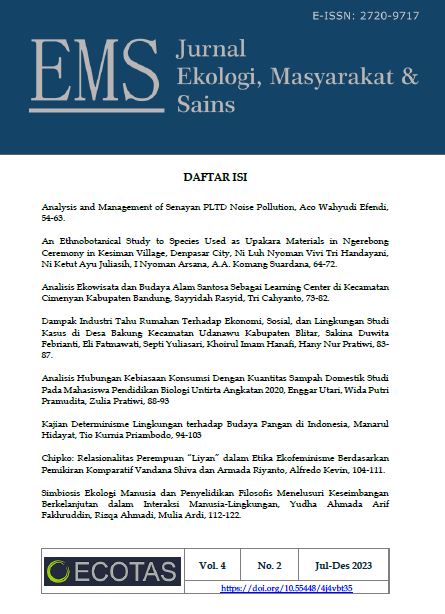Analisis Hubungan Kebiasaan Konsumsi Dengan Kuantitas Sampah Domestik
Studi Pada Mahasiswa Pendidikan Biologi Untirta Angkatan 2020
DOI:
https://doi.org/10.55448/jnr5kk82Abstract
Domestic waste is waste that comes from human daily activities in the household which does not include feces and specific waste. Domestic waste is divided into two based on its nature, namely organic waste and anorganic waste. The purpose of this study was to determine the comparison of the amount of domestic waste produced by 5th semester students of Untirta Biology Education during a period of one week. as for the analytical method used in this study is a quantitative descriptive approach. The results of the study found that anorganic waste had a higher amount, namely with a percentage of 65% compared to organic waste with a percentage of 35%. This difference can be caused by the advantages possessed by anorganic waste to help human daily activities and the existence of housing for students such as living with parents or living in boarding houses or dormitories
References
Alfiati, Siska. 2018. “Analisis Faktor-Faktor Yang Mempengaruhi Pola Konsumsi Pangan Rumah Tangga.” Journal of Economic, Business and Accounting (COSTING) 2 (1): 1–8.
Fadhilah, A., Sugianto H., Firmandhani, S., Murtini, T., Pandelaki, E. 2011. “Tata Cara Pengelolaan Sampah Kampus Jurusan Arsitektur Fakultas Teknik Universitas Diponegoro.” Modul 11 (2): 62–71.
Febriadi, Ihsan. 2019. “Pemanfaatan Sampah Organik Dan Anorganik Untuk Mendukung Go Green Concept Di Sekolah.” Abdimas: Papua Journal of Community Service 1 (1): 32–39.
Giordano, Claudia, and Silvio Franco. 2021. “Household Food Waste from an International Perspective.” Sustainability (Switzerland) 13 (9).
Hayat, and Hasan Zayadi. 2018. “Model Inovasi Pengelolaan Sampah Rumah Tangga. JU-Ke (Jurnal Ketahanan Pangan).” Jurnal Ketahanan Pangan 2 (2): 131–41.
Herlianti., Kuswanto, E & Ifrianti, S. 2012. Identifikasi Sampah Rumah Tangga Pada Masyarakat Kecamatan Sukarame, Kota Bandar Lampung. Prosiding SNSMAIP III. Universitas IAIN Raden Intan Lampung
Nurfirdaus, Nunu, and Risnawati. 2019. “Studi Tentang Pembentukan Kebiasaan Dan Perilaku Sosial Siswa (Studi Kasus Di SDN 1 Windujanten).” Jurnal Lensa Pendas 4 (1): 36–46.
Nuriyanto, M. Z., Zaenal Abidin, Alif Syahfiar, F. A. Firmansyah, W. J. F. Rianto, Ica Prasetyono, F. N. Pahlevi, F. A Ikhsan, and F. A Kurnianto. 2018. “Nuriyanto2019 Sudah.” Jurnal Universitas Jember 2 (2): 1–13.
Prasetya,W & Huda, M. 2023. “Analisis Perilaku Konsumsi Mahasiswa Muslim Fakultas Ekonomi Dan Bisnis Universitas Mulawarman.” Jesm: Jurnal Ekonomi Syariah Mulawarman 2 (1): 19–26.
Resmi, Nanda, and Tri Wismiarsi. 2015. “Pengaruh Kemasan Dan Harga Pada Keputusan Pembelian Minuman Isotonik.” Manajemen Dan Bisnis 13 (1): 2–20.
Saputro, W & Santoso, A. 2021. “Faktor-Faktor Yang Mempengaruhi Perilaku Food Waste (Studi Kasus Masyarakat Kota Surakarta).” Agritepa 8 (2): 165–74.
Sari, Etika, Merina Merina, and Eka Lestari. 2023. “Pemanfaatan Sampah Anorganik Menjadi Produk Kreatif.” Literasi: Jurnal Pengabdian Masyarakat Dan Inovasi 3 (1): 442–45.
Suharyono. 2018. “Perilaku Konsumen Dalam Perspektif Ekonomi Islam.” Al-Intaj 4 (2): 308–27.
Sumatri dalam Irwanto. 2021. “Pemberdayaan Anak Kost Di Pondok Winaya Kota Serang-Banten” 5 (5): 1181–94.
Suraji, Robertus, and Istianingsih Sastrodiharjo. 2022. “Edukasi Pemakaian Plastik Sebagai Kemasan Dan Minuman Serta Risikonya Terhadap Kesehatan Pada Masyarakat.” Jurnal Abdimas Ekonomi Dan Bisnis 2 (1): 1–9.
Ufrida, Khudhriyatul, and Sugeng Harianto. 2022. “Konsumerisme Makanan Siap Saji Sebagai Gaya Hidup Remaja Di Kota Surabaya: Studi Kasus Siswi Sma Muhammadiyah 4 Kota Surabaya.” Jurnal Analisa Sosiologi 11 (1): 137–56.
Yusiyaka, Rahmi Alendra, and Ana Dwi Yanti. 2021. “Ecobrick Solusi Cerdas Dan Praktis Untuk Pengelolaan Sampah Plastik.” Learning Community : Jurnal Pendidikan Luar Sekolah 5 (2): 68–74. https://doi.org/10.19184/jlc.v5i2.30819.
Zebua, Astri, Syaiful Hadi, and Djaimi Bakce. 2019. “Analisis Faktor-Faktor Yang Mempengaruhi Pola Konsumsi Pangan Rumahtangga Petani Sayuran Di Kabupaten Kampar,” 163–72.
Downloads
Published
Issue
Section
License
Copyright (c) 2023 Jurnal Ekologi, Masyarakat dan Sains

This work is licensed under a Creative Commons Attribution-NonCommercial 4.0 International License.
Authors of articles published in Jurnal EMS are permitted to self-archive the published/PDF version anywhere.





























